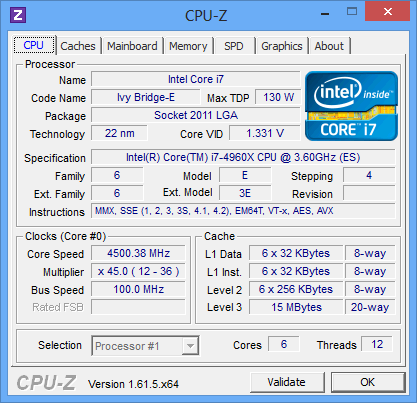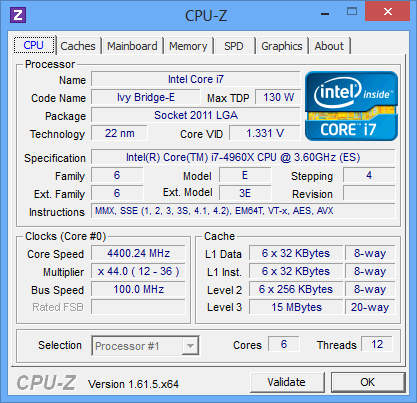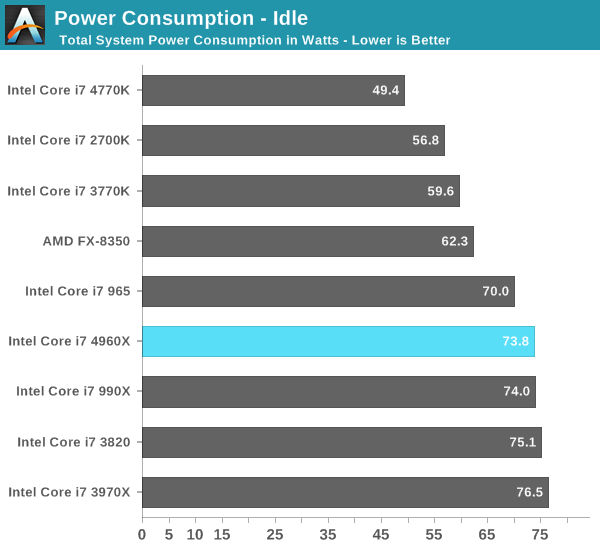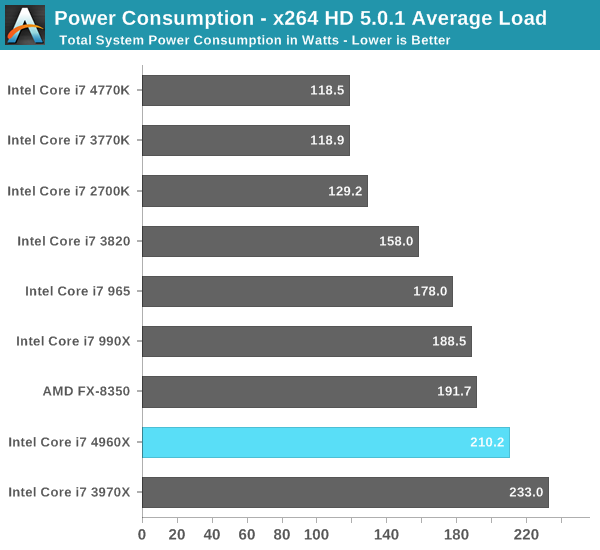Intel Core i7 4960X (Ivy Bridge E) Review
by Anand Lal Shimpi on September 3, 2013 4:10 AM EST- Posted in
- CPUs
- Intel
- Ivy Bridge
- Ivy Bridge-E
Overclocking
As I mentioned earlier, all of the IVB-E launch SKUs ship fully unlocked. Intel offers multipliers up to 63x for you to choose from when overclocking. Like SNB-E before it, IVB-E supports specific BCLK straps (125MHz and 166MHz, in addition to 100MHz) for those overclockers looking to get the absolute most out of their chip. At these overclocked BCLK frequencies, PCIe and other buses are properly divided down so they aren't overclocked (although if you increase the BCLK frequency beyond these strap defaults you will once again be overclocking other buses that derive their frequencies from BCLK). In practice, the cleanest/simplest way to overclock any K-series SKU is by increasing the multiplier.

In our review of the Core i7-3960X I managed a maximum stable overclock of 4.6GHz. I've been told to expect a similar average for Ivy Bridge E. Using Intel's RTS2011LC self contained/closed loop liquid cooling solution I could get into Windows 8 as high as 4.6GHz at 1.42V, however my testbed wasn't stable through all of my tests at that frequency/voltage combination. Moving to higher voltages didn't help, so I had to back down on frequency. I ultimately ended up perfectly stable at 4.3GHz, with 4.4 - 4.5GHz possible with better cooling. The added power needed to hit these frequencies was substantial. I measured a 58W increase in average load power consumption at 4.3GHz/1.4V.

From what I've seen, my sample is a bit on the disappointing side in terms of overclockability. Either way, it doesn't look like you're going to be seeing overclocks significantly higher than what was possible with SNB-E.
Power Consumption
With the 4960X delivering around 5% better performance than the 3970X, the only remaining question is how much more power efficient the move to 22nm made things. Using the same ASUS X79 Deluxe board for both parts, I was able to answer that question.
At idle there's hardly any difference between SNB-E and IVB-E. Under load it looks like IVB-E is good for around a 20W reduction in total system power. It's not an insignificant savings, but definitely not enough to warrant an upgrade if you're on SNB-E already. Anyone looking to migrate to LGA-2011 for the first time will want to go with IVB-E as it is the more thermally efficient solution.












120 Comments
View All Comments
Kevin G - Wednesday, September 4, 2013 - link
I believe the only way to get a specially binned or configured chip from Intel is to be an OEM and order a large volume. For an unlocked Xeon, the only chance Intel would release such a system would be under contract for a super computer contract that also used liquid cooling.OEM's like HP, Dell and Apple can also acquire specifically binned chips for a premium if the OEM wants something better or for a discount if Intel has excess inventories of low grade chips they need to sell.
1Angelreloaded - Tuesday, September 3, 2013 - link
Apple was the one who petitioned Intel to put the GPU on Die, so they could get away selling at higher prices with a lower cost to them. Do like I do BLAME APPLE.colonelclaw - Tuesday, September 3, 2013 - link
In conclusion, if you're an enthusiast who wants a high core count, Xeon is your only choice. For the price of the top-end Xeon you can buy a pretty decent second-hand car!We really need AMD to get back into the high-end game.
f0d - Tuesday, September 3, 2013 - link
yeah cpu's were much better when amd competed in the high endlets just hope they can pull a good one out of somewhere
Casper42 - Tuesday, September 3, 2013 - link
Hate to burst your bubble but AMD is going through a bit of a reset right now.Opteron 6400s in 2014. Minimal increase in performance.
Next Gen Ground Up architecture is 2015, or when you get your AMD rep drunk at a trade show, you hear more likely 2016. If they can pull it off, this is where they will become a player again.
Most of their attention at the moment is Trinity style APUs with minimal Core Counts just like Intel's desktop stuff.
DG4RiA - Tuesday, September 3, 2013 - link
When are these E5 V2 Xeons gonna be out ? Why release this first instead of the new Xeons ?Hardly any performance increase after 22 months. I get that they want to be able to sell the 12-cores Xeon for three grands instead of one, but why can't they just add two extra cores to 4960X instead of just adding 200MHz ?
Casper42 - Tuesday, September 3, 2013 - link
E5-2600 v2 is next week, Septh 10thE5-4600 v2 and E5-2400 v2 will be very end of 2013 or early 2014.
E7 (Ivy EX) will also be like January 2014. 15 cores is what I am hearing there.
DG4RiA - Wednesday, September 4, 2013 - link
Thanks for the info. I'm looking at dual socket build, so hopefully these V2 Xeon is worth the wait.Shadowmaster625 - Tuesday, September 3, 2013 - link
Intel is so greedy. They could have made this chip 10 core / 20 thread and the die size still would have been less than SNB-E. For a high end part, a chip this small is just a slap in the face. I hope their greed costs them lots of $$.ShieTar - Tuesday, September 3, 2013 - link
Sure. Also, the TDP at close to 4 GHz would have been 220W. And the majority of customers would have tried to overclock them and drive 300W through them. And either complained because they damage too easily, or because of the lousy overclocking potential.